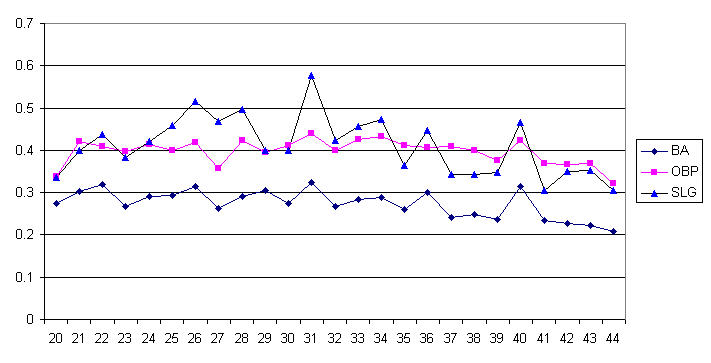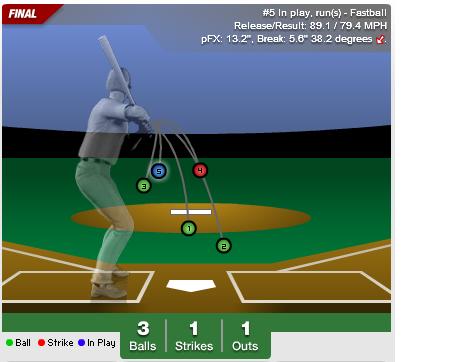The shadow of Wilkerson
2008 line in 54 plate appearances: .182/.308/.250
Career average: .249
Last season he hit near that: 2005 (.248)
Career OBP: .353
Last season he got on base at that clip: 2005 (.351)
Career SLG: .448
Last season he hit for that kind of power: 2007 (yay!) (.467)
Ground/fly ratio: .81 2008, .81 career
Line drive percentage: 12.1% 2008, 21% career. Last time he hit that many line drives: 2005 (24%)
Ground ball percentage: 39.4% 2008, 35.2% career
Fly ball percentage: 48.5% 2008, 43.7% career
Infield fly ball percentage: 31.3% 2008, 8.5% career
Percent of fly balls that go for home runs: 0% 2008, 13.4% career
Batting average on balls in play, by year, from 2005:
.317
.296
.280
.242
Sexson and old player skills
One of the things we’ve mentioned a couple times in discussing Sexson is the concept of young player skills and old player skills, and I thought I’d spend a second and talk about what that means and what it implies. Warning! Many generalizations ahead before I talk about Sexson again.
In the largest sense, young player skills are speed and contact hitting. Putting the ball into play and running it out. You can think of speed and defense in here too, if you want, but I’m ignoring that for now. A current classic young-player hitter skill set is someone like Ichiro — high batting average, doesn’t walk very often, doesn’t hit home runs. Their extra-base power comes out of doubles.
Old player skills are walks and hitting for power. They stop being able to beat out infield hits as they slow, some of their well-hit doubles turn into long singles, while others go over fences. Think David Ortiz, or to some extent Raul Ibanez. The three true outcomes, where the defense isn’t involved at all: K, BB, or HR.
Now, players can be young and hit for power and walk, and old and hit for a high average and swing at everything. But generally speaking, as they get older, players swing at less and less and hit the balls they do swing at harder.
Now the balance between these two, when a player’s experience combines with ability to produce the greatest production, generally happens at about 27. It can happen a lot earlier, it can happen a lot later (and those spikes are more common than I think is usually recognized) but generally speaking, players get better until about 26-28, then start their decline.
That progression’s led to one of the great discoveries of sabermetric research. Once people started to be able to look at huge sample sizes over long periods of time, we found players who display old player skills don’t age well at all. If a player debuts hitting .280 with tons of walks and monster power, they generally don’t have the kind of careers that a top young speed-and-contact hitter might.
It makes sense. If a player has a really fast bat, they can afford to lose a little of that as they age, get better at recognizing pitches and driving them. But if they’re already reliant on those things, losing that bit of bat speed means their average goes from .275 to .250 to .225 and they’re no longer effective hitters.
Here’s a nice little graph I think demonstrates this well:
(If you can’t guess who that is, I’m not going to tell you.)
Except that he always had a great eye. And his peak in these raw stats is age 31. Anyway, you can see over the course of his career his batting average declines as he ages until he just can’t effectively make contact but he’s still drawing walks. The power, though, goes up as he ages, spiking way up in his age 31 season. His best pure-power years are, in order, 31, 28, 27, 26, 34, 33, 25, 32, 40, and at number ten, 36 (24 is #11, 43 is #12). Considering his entire baseball-playing career, it’s clear that power is a relatively late skill that developed with experience.
A player can be hugely productive with old player skills. They K, they walk, they hit home runs. The top three players on the single-season strikeout list had great offensive seasons (Howard 2007, Dunn 2004 and 2005). This is the Sexson we’ve been seeing lately, a threat to lead the team in walks, strikeouts, and home runs at the end of the year.
But it’s extremely difficult to be a productive player hitting .250 for any length of time. If a hitter can’t put a strike into play for a hit, they’ll be challenged continuously, and things get really ugly really fast. It’s the cliff (the Cliff, sometimes) that’s cause for anxiety, and that’s why you get all the hand-wringing from me about what he’s hitting, what he’s laying off, and so on. They can fight it, but even the most talented players end up like Rickey Henderson in his last seasons, where he could not turn strikes even into singles, so he’d foul balls off until he drew a fourth ball. Less talented players – and every hitter is less talented than Rickey – don’t fare nearly as well.
What I’m worried about (and I think Dave would agree here) is whether or not a couple of things have happened, in descending order of the heartburn they induce:
– his bat speed’s deteriorated enough that he can’t be an effective hitter at all
– his bat speed’s down enough that his approach is falling apart, in consistency or
– his bat speed’s lost enough that he has regular, exploitable flaws
The last one’s the biggie. We’ve clearly seen some different versions of Sexson in the last few weeks, from disoriented and hacking to passive and bashing, and there’s the Rob Deer facsimile that can produce above-average offense while sporting an ugly batting average and striking out frequently.
We can’t know what it’s going to be for a while. This is really an area where we don’t have good enough tools. We can look at the Pitch F/X data, but we can’t look into Richie’s head and see what he’s seeing, or measure his reaction speed, or all that. We can’t know if he’s lucky or adapting, or if he was lost or got beat by a good pitch sequence. We’re just guessing.
There are other teams with advance scouts who will be looking at his video with a far more discerning eye and better tools than I have access to, so we’ll get some of these answers as the season goes on. If he’s unable to make good contact on pitches of a certain type in a particular location, he’ll be getting a steady diet of them soon enough.
It’s a measure of how important his offense is to the team that we all spend so much time wondering about it, and I squint at the good at-bats and bad trying to see if he’s coming around, getting lucky, both, or what. A productive Sexson, even if not up to career norms, provides power and walks to a team that sorely needs them, and a repeat of last season’s performance could badly hurt an offense that doesn’t have an easy way to solve for his absence.
Top Mariner Old Player Skill Seasons
(% of PA that ended with a walk, strikeout, or HR, min 400 ABs)
1. Jay Buhner, 1997, 51%
2. Richie Sexson, 2005, 46%
3. Mike Cameron, 2002, 45%
4. Jay Buhner, 1996, 44%
5. Jay Buhner, 1991, 43%
6. Gorman Thomas, 1985, 43%
7. Danny Tartabul, 1986, 42%
8. Jay Buhner, 1995, 42%
9. Mike Blowers, no question about it, 1995, 41% (Buhner hit 17 more HRs, walked seven more times, and struck out eight fewer times that year)
10. Mike Cameron, 2001, 41%
Sexson’s 2006, if you’re curious, is #14. He’s on pace to get over 47% on the season, though, which would be amazing and still not enough to catch Buhner.
The all-time record is Mark McGwire’s 1998, when ~58% of his plate appearances resulted in a walk, strikeout, or home run.
So when we say old player skills, I hope everyone understands that we don’t mean “stinks” — we’re trying to describe a particular offensive profile, and talk about how players age and what it means for Sexson’s career. There’s cause for both hope and worry in his performance so far, but we’ve seen players succeed for the Mariners with that skill set before, and we’ll see it again — hopefully for the rest of this year for him.
In The Interest Of Fairness
At the beginning of the year, we showed you some images from MLB.com’s gameday showing Richie Sexson having some truly horrible at-bats. Well, today, he did this:
There might not be 10 people on the planet who could have hit that pitch for a home run. Yes, it was an 89 MPH fastball on a 3-1 count, but the location was not exactly one where you expect a guy to be able to get his hands in and turn on it. Sexson’s had some good at bats lately, and this one was one of the best.
Thank You, Mike Scioscia
Let’s see – bases loaded, 2 outs, bottom of the 9th, lefty reliever on the hill, and you’ve got two options:
LH Garret Anderson, career vs lefties: .290/.308/.443
RH Torii Hunter, career vs lefties: .282/.339/.490
It’s worth noting that Hunter’s posted an OPS of .900+ against LHPs in each of the last three years as well. His career numbers vs lefties are deflated by poor performances earlier in his career, and our expectation of his actual ability should be weighted towards more recent performances. So, Hunter’s likely an even better true talent hitter against southpaws than this shows.
If you’re Mike Scoiscia, this is a pretty easy call, right? Hunter’s the better hitter and has the platoon advantage. Even if you believe in stuff like playing the hot hand and clutch hitting, well, Torii Hunter wins there too. Anderson’s hitting like the broken down old shell of his former self that he is, and lefties have dominated him this year. Hunter, meanwhile, tore the cover off the ball all weekend.
As a Mariner fan, I’ll simply thank Scioscia for the gift. But man, what a terrible decision that was.
Game 20, Mariners at Angels
Batista v Moseley. It’d sure be nice for the team to get out of town with a win here.
Blue Jays Release Frank Thomas
The Jays released The Big Hurt today, rather than be on the hook for a $10 million vesting option in 2009. No other team was going to pick up that contract either, so just eating the deal outright was the Jays only real alternative, since Thomas had no interest in being a part time player. I wrote up a longer post on this over at fangraphs.
Should the M’s pursue Thomas? It’s an interesting question. He’s undeniably better than Jose Vidro, and he can still provide some offensive thump from time to time. The Mariners could use another power hitter, and getting Vidro out of the line-up on a regular basis means that his terrible option won’t vest for 2009 either. (Note – since Thomas was released, his contract will not carry over to his new team. The Blue Jays deal with him will be irrelevant to whatever the M’s would give him – no vesting option to worry about.)
However, I’m not sure Thomas is what the M’s really need. He’s a right-hander who hits over half his balls in play into the air, making him an awful fit for Safeco Field, even though he does have opposite field power. Replacing Vidro with Thomas makes the line-up even more RH heavy (leaving only Ichiro, Ibanez, and Wilkerson as LH hitters), and would prevent the team from considering acquiring an outfielder and shifting Ibanez to DH, which really should have happened two years ago.
Thomas wants to play and the M’s need a hitter or three, so it would make some sense, but I’m not sure he’s an ideal fit here. He’d make the team better, but perhaps not better enough for it to matter, and the opportunity cost of making an even more impactful move down the line is fairly high. I can see reasons for and against.
In the end, what it comes down to for me is this – if the team is completely unwilling to make Ibanez a DH in 2008, then they should make a play for Thomas – they won’t get a significantly better bat at the deadline to replace Vidro, and they get an extra few months of upgrade instead of waiting until the summer. But if the team is willing to consider improving the defense and getting a left-handed hitting outfielder, that would be a better move.
Divisional play math

“nelly + simba” by ynskjen, cc-licensed.
The M’s and Angels have played 5 games, it’s 2-3 for the M’s. There are 14 (!) games between them remaining. If you figure that they’re perfectly equal teams in terms of quality, the importance of these games becomes a little shocking.
Split the remaining 14 games: M’s finish back one. (9 wins v Angels + n other season wins versus 10 wins v Mariners + n other season wins)
M’s go 6-8: M’s finish back three (8 wins v Angels + n other season wins versus 11 wins v Mariners + n other season wins)
M’s go 5-9: M’s finish back five
… and so on.
To make up that gap during the other games, the M’s have to be a significantly better team when not playing the Angels. Making up a one game gap is ~.01 win percentage. Making up three games requires them to put up a ~.02 win percentage. A five game gap — ~.035.
Or, since that’s not really intuitive, if the M’s split the remaining 14 games, the rest of the season they have to play like an 82-win team to catch the Angels if the Angels play .500 ball the rest of the year. Not that hard.
If they go 6-8, they have to play like an 84 win team.
If they go 5-9, they have to play like an 87 win team.
… and so on. And that assumes the Angels tread water the rest of the year. If you think they’ll do better than .500, the difficulty ramps up even more.
The short of it is that getting into a hole against a divisional rival makes getting to the playoffs a lot tougher. Hopefully the M’s can turn this around today.
Ow, ow, ow
That was no fun to watch.
Dave adds: Also, Wlad hurt his knee down in Tacoma tonight. Initial reports are that it’s bad.
Game 19, Mariners at Angels
I spent my day plumbing, and fully intend to set myself down on the couch with some kind of refreshing beverage and relax. I hate plumbing.
Washburn v Santana. 6:05.
Marzano dies
He was 45. I always liked Marzano, and enjoyed his time guesting on Mariners broadcasts.


